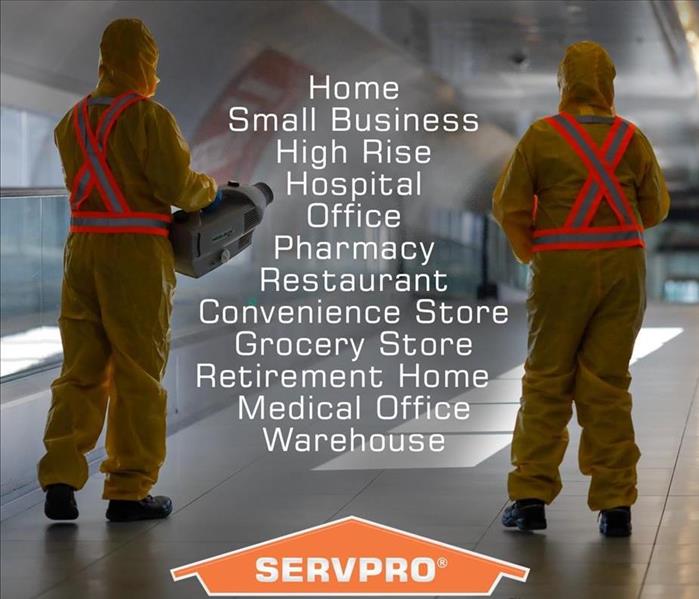Blog 4: Clean up Procedures Related to COVID-19
6/4/2020 (Permalink)
 Let SERVPRO of Jacksonville Beach/Ponte Vedra clean your commercial facility. Call today for a free estimate, 904-246-6118
Let SERVPRO of Jacksonville Beach/Ponte Vedra clean your commercial facility. Call today for a free estimate, 904-246-6118
Clean up Procedures
These procedures focus on the critical role cleaning plays in preventing the transmission of viruses, such as Coronavirus. Cleanup procedures may vary depending on the environment, but the general guideline includes [1] disinfectant selection, [2] cleaning and sanitizing of porous and non-porous surfaces, [3] disinfecting of non-porous surfaces, [4] cleaning and disinfecting of equipment, tools, and/or supplies used for cleanup process, [5] post clean up evaluation, and [6] disposal of waste.
1. Disinfectant Selection
The CDC recommends usage of a disinfectant with the EPA-approved emerging viral pathogens claim. As of the date of this publication, there are no disinfectants that have been tested specifically for use against novel coronavirus SARS-CoV-2, the Cause of COVID-19. However, disinfectant manufacturers (including SERVPRO) are working with the EPA to have the emerging viral pathogen claim added to existing products that are designed to kill viruses similar to SARS-CoV-2.
2. Cleaning and Sanitizing of Porous and Non-porous Surfaces
The CDC describes cleaning as removing germs, dirt, and impurities from surfaces or objects. Cleaning works by using a detergent and water to physically remove germs from surfaces. This process does not necessarily kill germs, but by removing them, it lowers their numbers and the risk of spreading infection.xx
Some materials cannot be cleaned with detergent and water without being damaged. For this reason, paper and paper products are not able to be cleaned and/or disinfected. Cleaning methods typically used on water sensitive materials such as vacuuming or dry sponging would not be capable of removing enough soil and residue to be effective.
For soft (porous) surfaces such as carpeted floor, rugs, and drapes, remove visible contamination if present and clean with appropriate cleaners indicated for use on these surfaces.xxi Surfaces that are not water sensitive, can be wet cleaned using a Hot Water Extraction or Deluxe Pre-conditioner and Rinse method. Upholstered items and carpets can be sanitized with certain disinfectants.
Affected laundry/linen items should be minimally handled. If the items can be laundered, SERVPRO of Jacksonville Beach/Ponte Vedra will launder items in accordance with the manufacturer’s instructions using the warmest appropriate water setting for the items and then dry items completely. Otherwise, SERVPRO will use products with the EPA-approved emerging viral pathogens claims that are suitable for porous surfaces.xxii
• SERVPRO will wash items as appropriate in accordance with the manufacturer’s instructions, and if possible, will launder items using the warmest appropriate water setting for the items and dry items completely. Dirty laundry that has been in contact with an ill person can be washed with other people’s items.xxiv
• SERVPRO will clean and disinfect hampers or other carts for transporting laundry according to the guidance above for hard or soft surfaces.xxv
Non-porous materials like hard surface floors, cabinets, countertops, doorknobs, and plumbing fixtures can be wet cleaned using a variety of SERVPRO hard surface cleaners (general-purpose cleaners) and cleaning methods. All cleaning procedures will be performed in such a manner as to minimize the splashing, spraying, spattering, falling, aerosolization, cross-contamination, migration, and generation of infectious material. We will avoid cleaning techniques such as pressurized air or water sprays, which may generate droplets or bio-aerosols.
3. Disinfecting of Non-porous Surfaces
The CDC describes disinfecting as killing germs on surfaces or objects. Disinfecting works by using chemicals to kill germs on surfaces or objects. This process does not necessarily clean dirty surfaces or remove germs, but by killing germs on a surface after cleaning, it can further lower the risk of spreading infection.xxvi
The application method should be selected based on surface type, location of surface, amount of surface area, and manufacturer recommended application method. Disinfectants can be applied using a saturated towel, spray bottle, pump-up sprayer, electric sprayer, ULV Mister, or electrostatic sprayer. SERVPRO of Jacksonville Beach/Ponte Vedra follows label directions for application and maintaining wet contact or dwell time as indicated by the manufacturer, which is critical.
Our technicians will be careful to prevent the over-wetting of electronic items, such as phones and computers to prevent potential damage.
4. Cleaning and Disinfecting of Equipment, Tools, and/or Supplies Used for Cleanup Process
Any equipment, tools, and/or supplies used by SERVPRO of Jacksonville Beach/Ponte Vedra for the cleanup process will be cleaned and disinfected using the cleaning methods described in steps 1 and 2. This is to ensure that potential contamination is not moved to other parts of the structure.
5. Post Clean Up Evaluation
At the time of this publication, there is no available surface test for the SARS-CoV-2 virus. There is currently no way to measure the effectiveness of the disinfection of SARS-CoV-2.
6. Disposal of Waste
SERVPRO of Jacksonville Beach/Ponte Vedra will follow all applicable federal, state, provincial, and municipal laws regarding the packaging, transportation, and disposal of medical waste. All disposable PPE (i.e. gloves, disposable respirators, coveralls), cleaning towels, and other waste will be bagged and sealed within the work area.
xx https://www.cdc.gov/flu/school/cleaning.htm
xxi https://www.cdc.gov/coronavirus/2019-ncov/community/organizations/cleaning-disinfection.html
xxii https://www.cdc.gov/coronavirus/2019-ncov/community/organizations/cleaning-disinfection.html
xxiv https://www.cdc.gov/coronavirus/2019-ncov/community/organizations/cleaning-disinfection.html
xxv https://www.cdc.gov/coronavirus/2019-ncov/community/organizations/cleaning-disinfection.html





 24/7 Emergency Service
24/7 Emergency Service